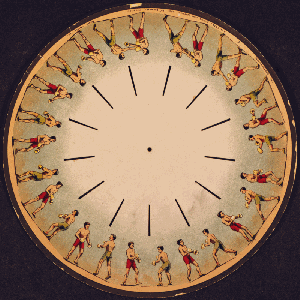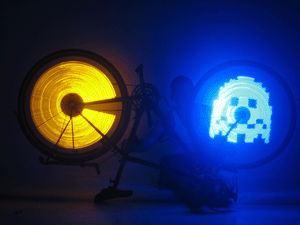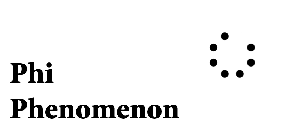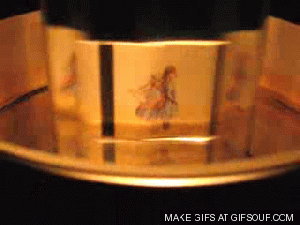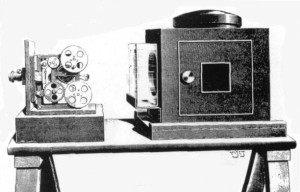Joseph Plateau was a Belgian Physicist who researched deeply into the human eye, focusing on the retina which lets the eye see colour. In 1832 he created the Phenakistoscope which consists of two disks, one with images, the other with small slits. The two disks spin in the same direction at the same time and when viewed through a mirror the illusion of motion is created.
The problems with the Phenakistoscope were that only one person could view it at a time, if spun too fast the image would be blurry and if it was to be spun backwards you wouldn’t see the correct moving image. The phenakistoscope uses the animation principle ‘Persistence of Vision’. Persistence of vision is the theory that the human eye can hold an image for approximately one twenty-fifth of a second on the retina, meaning what we see is a subtle blend of what is happening now and what has happened a fraction of a second ago. The best example of this is when you shake something quickly and see that object multiple times.
William Horner created the Zoetrope in 1834, which is a circular device which creates the illusion of movement when spun. This device didn’t need a mirror to see the moving images and more than one person could view it at a time. Hand drawn pictures were placed around the inside on the zoetrope and small slits were cut out above the pictures.
The Zoetrope used the animation technique Phi Phenomenon which is apparent motion.
Phi Phenomenon is the idea of movement as our brains “fill in the gaps”. When looking at the image a dot will disappear after the other, however our brains look at this as if an object is over the dot. This illusion of movement is important when it comes to stop motion, as each time you move your character the audiences brain will fill in the blanks by creating the illusion of movement.
Charles-Emile Reynaud developed the praxinoscope in 1877, which used a strip of pictures stuck inside a spinning cylinder with an inner circle covered in mirrors, instead of having small slits around the outside like the zoetrope. This method allowed a more stationary photo which was a lot less distorted than the image a zoetrope would provide.
Eadweard Muybridge famously proved that a horse has all of its legs off the ground at one time when it runs. To prove this theory he set up multiple cameras which would be triggered by a galloping horse when it ran past them. To share his work Muybridge invented the Zoopraxiscope, which is a method of projecting animated versions of his photographs as a short moving sequence.
Thomas Edison was the inventor of the Kinetograph in 1891 which was his idea of creating a device which links audio and visuals together. By 1918 he stopped working with film altogether after heated legal battles with competitors.
Beta Movement
Beta Movement leads to apparent motion.
It is the creation of movement when the object changes its location/ shape/ size/ angle ect. Looking at the image the dot has moved slightly ahead of the previous dot making it seem as if it is moving across the screen.
Beta movement and Phi Phenomenon are very important when it comes to stop motion, as the majority of your frames will include some method of movement, by simply just moving the object.
Frame Rates
Stop motion is typically shot at 24 frames per second, whereas full motion video is approximately 30 fps.
When animating your character you can shoot in either ones and twos. Shooting in Ones simply means that the animator moves the character each frame, whereas shooting in Two’s means the animator takes two photos/ frames for each movement. Shooting in ones provides a smooth image but it takes a lot longer to create, Shooting in twos provides a less smooth image but takes a lot less time.
Animators can move between shooting in ones and twos. For example, if an animator animates a character walking down a street on twos and a car drives by quickly in the same shot, the animator will want that car to be animated on ones, otherwise it wont look right as it passes the screen. That means the animator would move the puppet and move the car, take a frame, then move the car again without moving the puppet and take another frame.
This video was one of the first to use stopping, which is a process of filming a video, stopping the camera, changing the environment and then recording again. James Stuart Blackton created ‘The Enchanted Drawing in 1906 which used the method of Stopping to make it appear as the actor was taking objects out of the drawing.
He introduced animation and other important film techniques that helped shape the development of cinematic arts.
Charley Bower is one of the most forgotten silent comedians, being the director of hundreds animated cartoons from 1916 to 1926.
In 1916 Bowers took on the role of being a Producer by opening his own studio and beginning to produce animated shorts. In 1924 his animated shorts began to include live action, where he’d cast himself as the lead. “It’s a Bird” was created in 1930 featuring a metal-eating bird – this is the only film which includes sound which Bowers himself appears in.
Willis O’Brien was the special effects artist behind the 1933 movie classic – King Kong. He animated dinosaurs for the film ‘The Lost World’, and his work for King Kong is considered a classic example of stop motion photography. O’Brien transformed filmmaking by inventing a new type of visual effect later used by other movies such as Jaws and Alien.
Ray Harryhausen was a special effects master who created films such as Jason and The Argonauts, The Clash Of The Titans, 7th Voyage of Sinbad, the list goes on. His passion for creating animations started when he was young, watching films such as The Lost World and King Kong as a child. He began to create small models using puppets to experiment how to animate characters. Willis O’Brien was an inspiration to him and they met when Ray was working on Evolution. Willis gave him a lot of advice on his models which led to the turning point in his designs making the movements more natural by studying anatomy to understands where muscles connect to certain bones.
Jan Svankmajeris a Czech animator and film director. His work, both short and full length films, are mostly surreal, making use of live-action, stop motion, claymation and puppet animation. In 1972 Svankmajeris was banned by the Government from making films, since they are strange, dark and disturbing, with a dark comedy side to them.
Sequential animation is simply showing multiple images creating the illusion of movement.
Movement is a huge part of stop motion. When a character is moving you need to take many things in to consideration, such as: weight and forces.
This video was shot with these things in mind. When the woman walks on the bed, it looks realistic as she bounces then she walks rather than being static and stiff. When the wind blows into her, the audience begins to believe that she is actually being blown away and picture her in a realistic environment rather then lying on a bed.
Currently, there are four main types/ styles of animation. Flip book animation is a creative way to animate purely using a pencil, eraser and a stack of drawing pads (post-it notes). This style can be very experimental since you have no limitations on what characters you can draw (if you’re good at drawing that is). Stop Motion animation uses figures and objects to create an animation. You take a photo for every frame and edit them together to create an illusion of movement. 2D animation is a digital method of flip book animation. You can use drawing software to help easily change the timings of your animation. 3D animation is the last type/ style of animation. It uses three dimensional virtual space and creates realistic and aesthetically pleasing surroundings using calculations to render images as realistic as real life ones.
What makes a good narrative? To achieve the intended response from the audience, show conflict, characters the audience builds a relationship with, and a satisfying resolution. https://kerrylhatfield.wordpress.com/boa-coursework/boa-tv-units/script-writing/
This link discusses more about the set up of a script and what a successful narrative should include.
Stop motion children’s programs such as Postman Pat do not include complicated animation techniques such as lip syncing and 24 fps. This is for a few reasons; they have a smaller budget, they need to create multiple episodes meaning they don’t have time to correct and accurately display lip reading, and children won’t really appreciate the use of these techniques. Feature length films tend to have a bigger budget and can spend weeks on just one minute of a stop motion, as they have the time and resources to do so.
(Edit Notes)
- Movement accelerate, decelerate, weight, force (woman in the bed)
- Visualisation (Tim Burton, Svankmajar)
- Narrative (willis obrien king kong, ray harryhausen clash of the titans, jason and the argument
- Working Methods (henry selick coraline, tim burton) hair, lip sync the camera
Bibliograph:
http://animationgeek.blogspot.co.uk/2011/01/early-pioneer-joseph-plateau.html
http://tomtyldesleyanimation1.blogspot.co.uk/2011/06/animation-pioneers-william-horner.html
http://www.earlycinema.com/technology/zoetrope.html
https://www.princeton.edu/~achaney/tmve/wiki100k/docs/Persistence_of_vision.html
http://www.mediacollege.com/glossary/p/persistence-of-vision.html
http://blog.production-now.com/2008/08/phi-vs-beta.html
http://www.macworld.com/article/1146623/stop_motion_Mac.html
http://www.infoplease.com/biography/var/willisobrien.html
http://biography.yourdictionary.com/willis-o-brien

